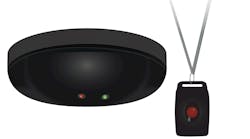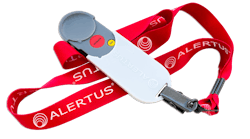Today, the vast majority of PERS units are connected to a landline — typically located in the kitchen or living room. The traditional PERS system consists of a base station with a speaker and a microphone, similar to a speakerphone, and a pendant that is worn by the user. When the user needs help, they press the button on the pendant and speak into the base station, which is connected to a central station. The central station operator evaluates the situation and summons the appropriate help.
One of the biggest drawbacks of base station systems is that customers can only talk to the operator through the base station, making it difficult to ask for help from other rooms, or when they are outside the house.
On top of that, as a way to save money, many seniors are replacing their landline phones with less expensive alternatives. This creates a need for new types of PERS solutions that do not depend on the type of phone used in the home.
Mobile PERS
Mobile PERS devices are miniature cell phones with two-way voice communication capabilities and emergency buttons that wearers can use to summon help.
Mobile PERS devices have many advantages over traditional PERS units, including tracking capabilities via a variety of technologies, such as GPS, WiFi and U-TDOA, which enable lost or disoriented users to be located and receive assistance. Some mobile PERS units are small enough to be worn around the neck with a lanyard; others attach with a clip to a belt or keychain. Most mobile PERS units are lightweight and durable, and some can also be worn in the shower. This is an important feature since many accidents involving seniors occur in the bathroom.
With a mobile PERS unit, the customer can speak directly through the unit with a call center specialist from any room in the house, as well as from the yard, garage — in fact, anywhere in the country that has cell phone coverage. No landline is needed with mobile PERS, and when seniors visit friends or relatives or go on vacation, they do not have to transport a bulky base station.
Future Applications
In addition to performing the functions of a traditional PERS while at the same time enabling users to remain social and active outside the home, mobile PERS units have the potential to leverage technology in new ways.
Mobile PERS devices are designed to be integrated into advanced M2M software platforms that are capable of tracking device battery life, providing reminder messages and assisting in the location of the user when they need help outside the home. As seniors live independently longer and learn the benefits of being able to talk to someone wherever they are and whenever they need help, more and more will want to have a mobile PERS device — even if they still have a landline.
Making the Mobile PERS Sale
With landline-based PERS systems rapidly becoming obsolete, and considering the advantages and possibilities offered by mobile PERS units, many in the industry expect significant organic growth. However, there are challenges involved in getting the word out about the advantages of mobile PERS. As a relatively new technology that is not typically sold in stores, mobile PERS devices are not as familiar as the ubiquitous, traditional PERS devices. Middle-aged people searching for emergency response solutions for their elderly parents may be more tech-savvy than their elders, but might not know enough about advances in PERS technology to search for mobile PERS units online.
Residential security dealers are a promising channel for the sale of mobile PERS technology. Security experts are already discussing ways to safeguard loved ones with potential customers, so offering a mobile PERS solution can expand their portfolio and provide customers with additional peace of mind.
By offering PERS solutions in addition to home security products, security dealers can increase incremental RMR and offer more features to customers, increasing the perceived value of their services. Adding PERS products to product lines allows dealers to become more diversified and increase sales, and it creates a one-stop shopping experience with many security solutions for customers.
“After procuring the right PERS and mobile PERS products, it is your basic blocking and tackling — sending email to your customer base and dropping off brochures at security installs,” says Bob Kelly, a consultant for home security dealers who enter the PERS market with ResponseNow. “From there, you develop relationships with social services and the medical community. As PERS sales increase, some security dealers establish a dedicated sales team to market PERS products.”
Whether through organic growth, advertising, word-of-mouth sales or residential security company placement, one thing is clear — the market for mobile PERS is growing. A large portion of our country is entering retirement now, and today’s seniors are living longer, healthier, more active lives; thus they want to keep their independence as long as possible. With expanded capabilities and almost limitless future applications, mobile PERS devices are destined to become an integral part of retirement in the 21st century.
Tom Collopy is CEO of Securus Inc., a provider of M2M Technology Platforms that enable mobile safety and security products. To request more info about the company, please visit www.securityinfowatch.com/10215054.


